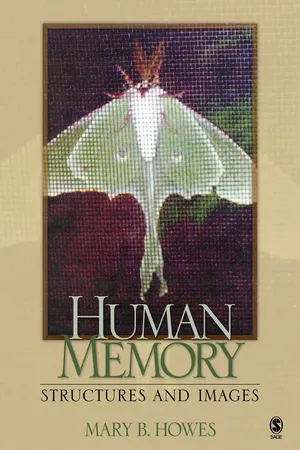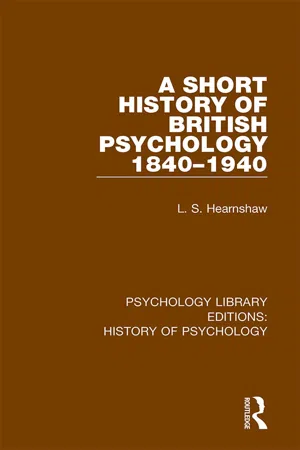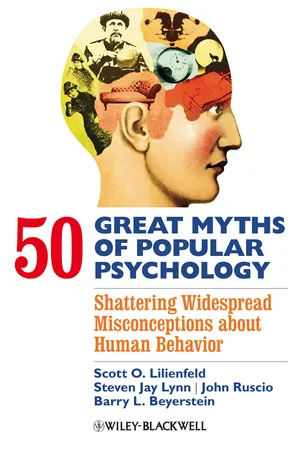Psychology
Bartlett War of the Ghosts
"Bartlett's War of the Ghosts" is a classic study in the field of cognitive psychology that highlights the reconstructive nature of memory. The study demonstrated how individuals tend to distort and reconstruct memories based on their cultural schemas and expectations. Bartlett's work has had a significant impact on our understanding of memory processes and the role of cultural influences in shaping cognitive processes.
Written by Perlego with AI-assistance
Related key terms
1 of 5
3 Key excerpts on "Bartlett War of the Ghosts"
- eBook - ePub
Human Memory
Structures and Images
- Mary B. Howes(Author)
- 2006(Publication Date)
- SAGE Publications, Inc(Publisher)
Another common change in the memory protocols involved the hiding place of the young men when they fled to shore. It had been a log. Some of the participants in the experiment (whom Bartlett called “observers”) recalled a boulder or a tree. This can again be seen as a reasonable inference, if an attempt is being made to reconstruct something large enough to hide behind, at the edge of a river, in Indian territory.Bartlett found that his observers generally recalled the first two thirds of the story, and its end, accurately and in some detail. In contrast, the battle scene was poorly recalled and often changed from the original.The battle scene does not make sense. Many on both sides were killed, and yet the warriors decide to go home when they note that someone has been hit. It is not clear who the ghosts are, nor is it clear what the young man suddenly sees or hears that makes him realize that “they” (whoever they are) are ghosts. As a result, recall of this component tended to be both weak and distorted in the effort to make the content sensible. Bartlett believed that many of his observers had taken “The War of the Ghosts” for an adventure story, thus making “adventure story” the higherorder schema for the passage as a whole. But the events of the battle scene do not fit the expectations generated by an adventure story.Bartlett suggested that higher-order schemas operate like doors. If you deploy an adventure story schema, you have walked through one door. Elements that do not fit your interpretation, although presumably understood as isolated statements, are quickly forgotten.A number of other critical points were developed within this context. According to Bartlett, events usually have “connections” that are often not stated in the text but are supplied by the reader. The effort after meaningfulness appears to be related to this finding of connections. Under the wrong higher-order schema, the reader may be looking for connections that cannot operate because the schema does not include or permit them.A second claim outlined, although not pursued, in 1932 was that emotion influences memory. Bartlett’s position was that emotional material is coded in a stronger fashion than neutral material. (The effect was unrelated to cue matching.) Thus he noted that of the four men in his original experiment who recalled the excuse of the arrows, all of them reversed the original order of the excuses, reporting first the “I might be killed” objection or the individuals’ family might be worried, and only second that he had no arrows. The participants in the study were young men at Cambridge during World War I (1914–1918); all were likely to be engaged in that conflict in the immediate future. - eBook - ePub
- L.S. Hearnshaw(Author)
- 2019(Publication Date)
- Routledge(Publisher)
2 In a psychological sense perceiving proved to be an exceedingly complex reaction, active and constructive in its essential nature, and involving imaging, valuing, the beginnings of judgement, an ‘effort after meaning’, and an inferential element. These conclusions led on to Bartlett’s famous experiments on remembering. Abandoning the use of nonsense syllables Bartlett employed pictures, pictorial symbols and prose passages. His subjects were asked to give repeated reproductions after varying intervals of time, sometimes a series of subjects being involved in the transmission of the material. In this way Bartlett was able to study the changes that took place in remembering. His interpretation of the experimental results was both stimulating and suggestive. Perceiving, recognizing and recalling were regarded as psychological functions belonging to a common series. All were determined not merely by sensorial data, but by ‘schemata’ and by attitudes. In a sense, too, each act of recall involved novelty; it was reconstructive, not merely reproductive, just as skilled acts were not mechanical motor habits but built up afresh each time to meet the demands of each situation as it arose.1 E. G. Chambers B. J. Psych., XXXIII (1943).2 Remembering, 14.The strength of Bartlett’s work was its capacity to embrace relatively complex functions such as are met with in real life, images and consciousness, for example, and the social factors involved in behaviour. Indeed the second part of Remembering was devoted to the social factors, “the passing fashion of the group, the social catchword, the prevailing approved general interest, the persistent social custom and institution” which set the stage for all human experience and behaviour. This emphasis on, and awareness of, social forces has been a constant feature of Bartlett’s psychology and found earlier expression in his Psychology and Primitive Culture (1923), and no doubt reflects the influence of W. H. R. Rivers.It was a natural transition from the constructive processes involved in remembering to the study of thinking. In his book on the subject,1 published six years after his retirement in 1952 from the Cambridge chair, Bartlett aimed to put thinking into its place as a development from earlier and simpler forms of skilled behaviour. Thinking “within closed systems” was concerned largely with “filling in gaps in information”; “adventurous thinking”, such as that of the experimental scientist or the artist, was concerned more with “going beyond the evidence”. Bartlett made some tentative suggestions for an experimental investigation of these ideas, and included some ‘case studies’ of thinking, but the book is a much slighter contribution to its subject than was Remembering - eBook - ePub
50 Great Myths of Popular Psychology
Shattering Widespread Misconceptions about Human Behavior
- Scott O. Lilienfeld, Steven Jay Lynn, John Ruscio, Barry L. Beyerstein(Authors)
- 2011(Publication Date)
- Wiley-Blackwell(Publisher)
reconstructive. What we recall is often a blurry mixture of accurate recollections, along with what jells with our beliefs, needs, emotions, and hunches. These hunches are in turn based on our knowledge of ourselves, the events we try to recall, and what we’ve experienced in similar situations (Clifasefi et al., 2007).Evidence for the reconstructive nature of memory derives from several lines of research. Psychologists now know that memory is schematic ; a schema is an organized knowledge structure or mental model stored in memory. We acquire schemas from past learning and experiences, and they shape our perceptions of new and past experiences. We all possess schemas about everyday events, like ordering food at a restaurant. If a waiter asked us if we wanted our dessert before the appetizer, we’d surely find this request bizarre, as it’s inconsistent with our restaurant schema or “script” for ordering food.Stereotypes afford an excellent example of how schemas can influence our memory. Mark Snyder and Seymour Uranowitz (1978) presented subjects with a detailed case study of a woman named Betty K. After reading this information, they told some subjects that Betty K was currently living either a heterosexual or a lesbian lifestyle. Snyder and Uranowitz then gave subjects a recognition test for the material in the passage. They found that participants distorted their memory of the original information, such as her dating habits and relationship with her father, to be more in line with their schema, that is, their knowledge of her current lifestyle. We reconstruct the past to fit our schematic expectations.Henry Roediger and Kathleen McDermott (1995) provided an elegant demonstration of our tendency to construct memories based on our schemas. They presented participants with lists of words that were all associated with a “lure word”—a single, non-presented item. For example, some participants studied a list containing the words thread, pin, eye, sewing, sharp, point, pricked, thimble, haystack, pain, hurt, and injection, all of which are associated in memory with the lure item needle.
Index pages curate the most relevant extracts from our library of academic textbooks. They’ve been created using an in-house natural language model (NLM), each adding context and meaning to key research topics.


